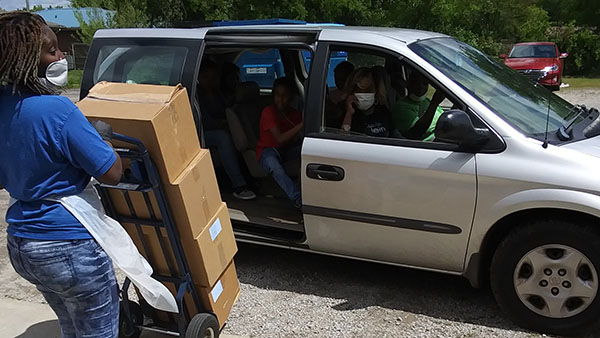When the COVID-19 pandemic forced schools to close in March, school systems across the state mobilized to feed children who depend on school meals.
Danielle Turk, a specialist in child nutrition programs for the Alabama State Department of Education, said school systems switched immediately to the U.S. Department of Agriculture summer food service program, Break for a Plate Alabama. The effort distributed more than 7.2 million “grab and go” meals from schools, churches and other community sites between March and May.
In need of food
Ava Wise of Project Hopewell, a Birmingham-based community nonprofit serving residents through a variety of social and education programs, said her team realized the need for food distribution as soon as schools closed. They began to spread the word, Wise said, and soon 17 Birmingham churches had joined the effort.
In a normal year, between 2.5 and 3 million meals are served to children each summer through Break for a Plate. Turk expects greater numbers for 2020 due to the pandemic.
“Children and parents are used to getting two meals from school daily whether they were free, reduced or paid,” Turk said, noting many paying families needed assistance this year after losing employment during the pandemic.
The summer food service program feeds all children 18 and under, regardless of income. USDA guidelines mandate onsite meal consumption for summer programs, but waivers were allowed this year for distribution of grab and go meals.
“The USDA waivers have really helped,” said Kellie Grubbs, child nutrition director for Cleburne County Schools in east central Alabama. Even prior to COVID-19, “eating on site was a deterrent for some families who didn’t have time to sit to eat their meals,” she said.
Alabama churches often serve as summer feeding sponsors or distribution sites, providing meals and activities for children through Vacation Bible School, day camps or other programs.
Church closures and meeting restrictions limited some church partnerships in March, Turk said, but many churches coordinated food distribution to families who couldn’t get to a school for meals.
“The schools were able to (distribute meals) effectively and feed more children while maintaining social distancing,” Turk said. “We got all the schools up and running to serve the children immediately. Some private nonprofits like Alabama Food Bank Association and Feeding the Gulf Coast were ready to switch gears early, but some of the other sponsors were in the midst of other things. Churches available to feed children were partnered with schools or one of the nonprofits to serve as distribution sites.”
Delivering meals
And in some cases, church volunteers took food to the children.
“Our neighborhood kids are bused to school,” Wise explained. “It’s not convenient for them to walk to school to eat. Many of the churches have driven to the areas where kids are to deliver meals.”
The effort helps families and introduces them to the local church — in this case, Hopewell Missionary Baptist Church-Hillman Station, Birmingham.
“People are saying they are going to come back when this is over and worship with us,” Wise said. “People want to stay connected because they realize that when things were at their worst we cared enough to see about them.”
For more information about summer feeding programs through the Alabama Department of Education and local child nutrition programs, or to find a local distribution site, visit breakforaplate.com.






Share with others: